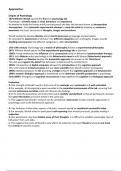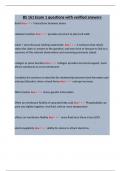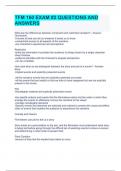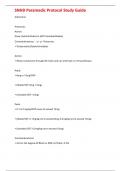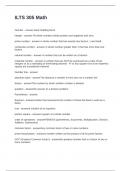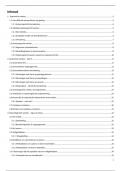Origins of Psychology
- 1879 Wilhelm Wundt opened the first ever psychology lab
- Psychology - scientific study of mind, behaviour and experience
- He wanted to study the human mind (consciousness) and later this became known as introspection
- Introspection - first systematic experimental attempt to study the mind by breaking up conscious
awareness into basic structures of thoughts, images and sensations
- Wundt wanted to develop theories about mental processes eg language and perception
- He recorded his experiences of stimulus’ into different categories such as thoughts, images, sounds
- Dividing consciousness into different categories is called structuralism
- 17th-19th century: Psychology was a branch of philosophy (known as experimental philosophy)
- 1879: Wilhelm Wundt opens the first experimental psychology lab in Germany
- 1900’s: Freud emphasised the influence of the unconscious mind on behaviour (psychoanalysis therapy)
- 1913: John Watson writes psychology as the Behaviourist views it with Skinner (Behaviourist approach)
- 1950’s: Rogers and Maslow develop the humanistic approach also known as the ‘third-force’
- This also went against the belief that behaviour is determined by outside forces
- 1950’s: Introduction of digital computers allowed the introduction of the cognitive approach
- This is the study of mental processes but was more scientific than Wundt's earlier investigation
- 1960’s: Bandura proposes his SLT providing a bridge between the cognitive approach and behaviourism
- 1980’s onward: Biological approach is established as the dominant scientific perspective in psychology
- Early 2000’s: Emergence of cognitive neuroscience brings together the cognitive and biological approach
Evaluation:
- P: One strength of Wundt's work is that some of his methods were systematic and well-controlled.
- E: For example, all introspections were recorded in the controlled environment of the lab, ensuring that
possible extraneous variables could not influence the findings.
- E: In his tests the procedures and instructions were carefully standardised so that all participants received
the same information and were tested in the same way.
- L: This suggests that Wundt's research can be considered a forerunner to later scientific approaches in
psychology, such as the behaviourist approach.
- P: One limitation is that other aspects of Wundt's research would be considered unscientific today.
- E: For example, Wundt relied on participants self-reporting their mental processes, possibly making it
subjective.
- E: Also participants may have hidden some of their thoughts. It is difficult to establish meaningful 'laws of
behaviour' from such data.
- L: This suggests that some of Wundt's early efforts to study the mind were flawed and would not meet
the criteria of scientific enquiry.
, Learning approaches: The behaviourist approach:
- Behaviourist approach - explaining behaviour in terms of what is observable and in terms of learning
- Behaviour that is observed - not concerned with mental processes - uses lab studies instead
- Mind is a blank state when individuals are born - behaviour learnt by classical and operant conditioning
- Classical conditioning - learning by association - Pavlov (1927) dogs learning to salivate
- Food is an unconditioned stimulus and salivation is an unconditioned response
- Neutral stimulus is the bell - ringing it leads to no response - Unless bell and food are associated
- Bell becomes a conditioned stimulus because it leads to an unconditioned response of salivating
- Skinner's (1953) - “Skinner's box” demonstrates operant conditioning - learning by reinforcement
- Procedure: Animals placed into Skinner's box a controlled environment and encountered levers or disc
When activated they would be rewarded with food - Skinner designed his box to deliver punishments -
when pulling the lever the rat would receive an electric shock
- Findings: When the rat realised the behaviour led to them being rewarded with food they would
repeat behaviour - avoid behaviour when received an electric shock - for a positive outcome
- Operant conditioning - behaviour is shaped and maintained due to consequences
- Possible consequences of behaviour include reinforcement (positive or negative) and punishment
- Reinforcement - consequence of behaviour that increases likelihood of behaviour being repeated
- Positive reinforcement is when you receive a reward when a certain behaviour is performed
- Negative reinforcement - avoids something unpleasant so the outcome is a positive experience
- Punishment - unpleasant consequence of behaviour - decreases the likelihood of that behaviour
Evaluation:
- P: One strength of the behaviourist approach is that it is based on well-controlled research.
- E: Skinner was able to clearly demonstrate how reinforcement influenced an animal's behaviour.
- E: All extraneous variables were removed so cause-and-effect relationships could be established.
- L: This shows that behaviourist experiments have some scientific credibility.
- P: On the other hand, behaviourists may have oversimplified the learning process.
- E: They have ignored an important influence on learning which is human thought.
- E: SLT and cognitive approach have drawn attention to mental processes involved in learning.
- L: This suggests it is not sufficient alone to use observational research to explain behaviour.
- P: One strength is real-world application.
- E: Behaviorist approach is successful in understanding how phobias are developed and maintained. This is
allowed psychologists to understand how to overcome phobias by devising treatments eg SD and flooding.
- E: Useful in understanding how elements of conditioning can be involved in the formation of attachment.
- L: This increases the value of behaviourist approach due to practical applications.
- P: One limitation is that the behaviourist approach may be reductionist.
- E: Skinner suggested that everything we do is the result of positive or negative reinforcement.
- E: This ignores possible influences such as free will on behaviour. Research has found that individuals
who have a strong belief in fatalism are at greater risk of developing depression.
- L: This shows that the behaviourist approach fails to accept other influences on behaviour such as the
possibility of free will which can overall have a negative impact on people's mind and behaviour.
, Learning approaches: Social learning theory:
- Social learning theory is a way of explaining behaviour that includes both direct and indirect
reinforcement which combines learning theory with cognitive factors
- Direct reinforcement is classical and operant conditioning
- Indirect reinforcement - vicarious reinforcement - occurs by observing someone else being imitating
- Imitation is copying the behaviours of others
- Bandura (1961) Bobo doll experiment
- Procedure: Children were exposed to a video where an adult exhibited aggressive behaviour such as
hitting a Bobo doll - Children were then placed in a room with many toys including a Bobo doll
- Findings: Children who observed aggressive behaviour in the video were more likely to imitate similar
aggressive actions towards Bobo doll during play than other children observing a non aggressive adult
- Children are likely to imitate people they identify with - identification
- Identification is when an observer associates themselves with a role model and wants to be like them
- The person they identify with is the role model - when they are being imitated it is known as modelling
- Modelling - observer's perspective is imitating behaviour of a role model. From role models perspective
modelling is showing exactly how to do something
- Mediational processes - cognitive factors such as thinking that influence learning
- Attention the extent to which we notice certain behaviours - learning behaviour
- Retention is how well the behaviour is remembered - learning behaviour
- Motor reproduction is the ability of the observer to perform the behaviour
- Motivation will to perform behaviour - determined by if the behaviour was rewarded/punished
Evaluation:
- P: One strength of the SLT is it recognises the importance of cognitive factors in learning.
- E: Classical and operant conditioning can’t offer an adequate explanation of learning on their own.
- E: Humans store information about behaviour of others and use this to make judgements about when it
is appropriate to perform certain actions eg a child observing a mother receiving praise for her work.
- L: This suggests that SLT provides a more comprehensive explanation of human learning.
- P: However SLT makes little reference to the influence of biological factors.
- E: Bandura believed that learning itself was determined by the environment the individual was in.
- E: Recent research suggests observational learning may be the result of mirror neurons in the brain,
which allow us to empathise with and imitate other people.
- L: This suggests biological influences in social learning theory were not emphasised enough.
- P: One limitation of SLT is the approach is based on research that comes from lab studies.
- E: Lab studies are criticised for controlled nature - participants may respond to demand characteristics.
- E: Some researchers believe children behaved the way they did because they thought that was expected
from them i.e. the main purpose of the doll is to strike it.
- L: This suggests that SLT lacks external validity and does not fully explain how behaviour is learnt.
- P: Another strength of SLT is it can explain how behaviour is developed across different cultures.
- E: Modelling, imitation and reinforcement explains how children learn from others around them
including media which can account for how cultural norms are transmitted through societies.
- E: This has been useful in understanding a range of behaviours eg how children understand gender roles.
- L: This increases the value of the approach as it can account for real-world behaviour.
, The cognitive approach:
- Cognitive approach is how our mental processes (perceptions and attention) can affect behaviour.
- This can’t be observed and so psychologists have studied them indirectly by making inferences
- Inference is how cognitive psychologists draw conclusions about the way mental processes work
- They do this using theoretical and computer models
- Mental processes can be affected by a person's belief or expectation - schema
- Schema is a mental framework of beliefs and expectations that influence cognitive processing. They are
developed from experience - they can be described as ‘packages’ of ideas and information
- Theoretical Models are abstract representations of mental processes. They explain how information
flows through the cognitive system in stages. This is to understands how the mind works in a general way
- Computer Models are concrete representations involving actual computer programming. They test the
instructions derived from theoretical models to see if they produce human-like outputs. If the computer
mimics human responses it suggests that similar mental processes may be occuring in human mind
- Cognitive neuroscience - scientific study of biological structures that underpin cognitive processes - how
the structure of the brain influences mental processes
- This can investigated using brain imaging techniques such as fMRI and PET scans
- By looking at brain images it has allowed us to understand how structure and function of the brain can
result in mental disorders eg how the parahippocampal gyrus links to OCD
Evaluation:
- P: One strength of the cognitive approach is that it uses objective, scientific methods.
- E: They use highly controlled methods so researchers are able to infer cognitive processes.
- E: Due to the highly controlled lab experiments conditions can be replicated to produce reliable and
objective data - biology/cognitive psychology come together enhancing scientific basis of the study.
- L: This shows that the study of the mind has a credible scientific basis.
- P: On the other hand cognitive psychology relies on inference of mental processes.
- E: The direct observation of behaviour can be too abstract and theoretical in nature.
- E: Research studies on mental processes are carried out using artificial stimuli that also do not represent
everyday experience.
- L: Therefore research on cognitive processes could lack external validity.
- P: Another strength of the cognitive approach is practical application.
- E: Cognitive psychology has made contributions to the field of AI and developments of robots - These
advances can revolutionise how we live in the future
- E: Cognitive approaches have also been applied to explaining and treating depression e.g. CBT.
- L: This shows the value the cognitive approach has had on the real world.
- P: One limitation of the cognitive approach is that it uses machines.
- E: Research has found that human memory may be affected by emotional factors - this can be seen by
the influence of anxiety on eyewitnesses.
- E: Computers don’t consider human emotion and how they affect our ability to process information.
- L: This shows machine reductionism may weaken the validity of the cognitive approach.


